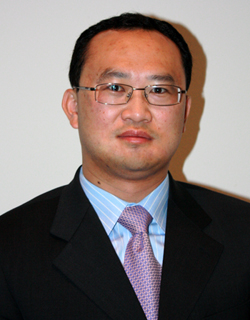Nuclear expansion in China
As the world's most populous country and fastest growing major economy, it's no surprise that China needs energy - lots of energy. Its thirst for oil has been a major driver for the dramatic increase in crude prices since 2004, and its heavy reliance on coal has created severe pollution problems and made China the world's largest emitter of CO2.
In a seminar on Tuesday (Nov. 2), Bo Kong, assistant professor at Johns Hopkins University's School of Advanced International Studies, described how China is confronting these issues by "diversifying" its energy sources and greatly expanding its use of nuclear power.
"China is not a large nuclear economy," Kong observed. It currently has 13 operating nuclear plants, producing approximately 11 gigawatts (GW) of power, representing less than 1 percent of China's total energy production.
(In comparison, the United States has more than 100 operating reactors producing roughly 100 GW and providing nearly 20 percent of its energy. France obtains more than 75 percent of its energy from nuclear power, Ukraine nearly 50 percent, South Korea more than 35 percent, Germany 28 percent, and Japan 25 percent.)
In 2005, the Chinese government recognized the need to reduce the country's reliance on coal (and thereby reduce carbon emissions) and increase its use of renewable energy supplies. "China considers nuclear power to be 'clean' energy," Kong explained, "and is aiming for a fivefold expansion in the next decade."
China leads the world in nuclear power plant construction. Today, 24 reactor units are under construction, which, when operational in 2015 or earlier, will generate a total of 26 GW of power. An additional 15 GW of nuclear power capacity is approved and in the pipeline for construction.
Unlike the United States, the Chinese public is generally supportive of nuclear power. "It's desired highly," said Kong, "because it brings jobs and provides security against power shortages." He noted that 16 localities have selected 51 preliminary sites for 244 reactor units, which if all built would bring 120 GW of power to inland China and 150 GW to the population centers along the coast.
Regarding the cost of nuclear power vs. coal power, Kong noted that the cost of transporting coal by rail or truck from where it is mined (in Mongolia) to where it is used (China's east coast) has risen steeply with the increased cost of oil. In addition, many older, inefficient and dirty coal-fired plants are being shut down and other plants are being retrofitted to reduce harmful emissions, all of which is increasing the cost of coal power. At the same time, the construction cost for nuclear power plants is coming down, in part due to the use of local materials and labor. "It's getting to where the cost of nuclear power in China is very competitive."
Kong noted, however, that this nuclear power expansion is not without challenges. For example, governance of civil nuclear power in China is fragmented among multiple agencies, with one agency responsible for approvals, another for safety, a third for security and emergency response, and so forth. "As one might expect, there is considerable overlap and confusion."
China also lacks an effective regulatory framework. "There is no overarching atomic energy law," Kong observed. Each agency has its own set of regulations. Some regulations are out of date and they are not designed to regulate the next-generation nuclear reactors that are in the planning stages. In addition, China has no nuclear liability legislation.
Other challenges include a shortage of funding and personnel to effectively oversee the civil nuclear power sector. "The NNSA [National Nuclear Safety Administration] is China's version of the NRC [Nuclear Regulatory Commission] and it has only 40 people to oversee 13 operational reactors. Compare this to the U.S., France, and Japan with 36 people and $11 million per gigawatt of nuclear power. China has a hundred times less. Yet NNSA can't expand due to political reasons," explained Kong.
China estimates that an additional 20,000 nuclear science professionals -- reactor engineers, nuclear chemists and physicists, radiation safety experts, metallurgists, materials scientists, etc. -- will be needed by 2020. "Chinese universities are only training hundreds of these people, not thousands."
Kong also highlighted safety and security challenges. "Safety culture is lacking in China. The current expansion has overstretched China's regulatory capacity. With the drive to construct many more power plants in a short period of time, there's a serious risk of reckless expansion and corner-cutting."
In the nuclear security arena, Kong noted that radioactive sources are pervasive across China and poorly regulated, no inventory of nuclear material has been established, and China's implementation of an MPC&A material protection, control, and accounting system is unverified. "There is complacency when it comes to nuclear security. China has never had a nuclear accident and doesn't think it is vulnerable to nuclear terrorism. Corporate leaders think nuclear security is a good idea but they don't want to spend money on it."
In Kong's view, these challenges present opportunities for U.S.-China nuclear cooperation to the benefit of both countries. "The United States could help train nuclear workers for China and provide expertise on nuclear safety. There could also be extensive engagement in the security of nuclear and radioactive materials and nuclear facilities, perhaps through a joint Center for Nuclear Excellence."






